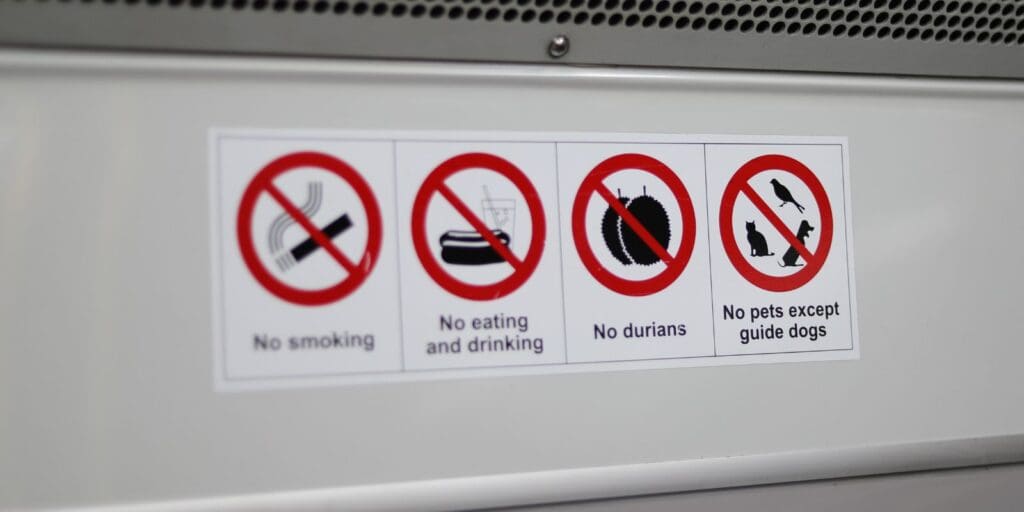Over the years, hybrid working has become more and more popular, with more businesses opting to offer it as a perk for employees to work for them. As hybrid work becomes more of a standard, businesses are having to reassess how workplace safety and compliance measures adapt to evolving office environments, and part of the adaptation involves UK compliant prohibition signs.
While much attention is often paid to technology, remote access, and flexible scheduling, the physical workplace still needs to meet legal and safety obligations, especially when the use of space changes frequently. To help you become more compliant, we have put together a guide on updating your UK compliant prohibition signs for hybrid work. Keep reading to learn more.
What Are Prohibition Signs
Prohibition signs are safety notices designed to make customers or workers aware of potential risks to health and safety. They are designed in a way to get your attention easily and make you aware of the notice they are presenting. A couple of examples include a no-smoking sign, a do not use out of order sign, a no parking sign, or a no dogs sign. The general public is used to seeing prohibition signs, as they are used across the country.
Steps to Update Prohibition Signage
Conduct a Site Assessment
Site assessments are important as they give you a live example of what you are doing well and not so well. In the case of prohibition signage, you should evaluate all workplace areas and review the signage you are currently using to ensure it’s still applicable. If you spot any old signage, ensure you replace it immediately.
Prioritise Clarity
Hybrid workers are working from the office some days and often at home the other days (or at co-working spaces). This means they will be less familiar with any new safety rules you may be telling your staff to follow. Make sure you dedicate some time to making them aware of any new signage as well as ensuring the signage is prominently placed, legible, and unambiguous.
Remove Outdated Signs
Never keep old or outdated signs up, as this is one of the quickest ways to cause confusion. As mentioned above, you should be doing a site assessment, which will give you that chance to review all your signs and remove any outdated ones.
Include Digital Communication
When you are making changes, don’t just rely on the new sign to do its job. Ensure you communicate these changes to the workplace through email or using your workplace CRM system. From a public point of view, a good example of this is Swansea. They have put out a list of roads set for repair in Swansea online, so that road users are aware of the changes before they happen. When drivers drive that way in the future, they aren’t completely surprised by any new signage.
Staff Training
It’s always useful to have refresher training sessions on health and safety, which will include signage. Over time, staff will forget certain information, which you can refresh through staff training. Training sessions can be done face-to-face or you can do them online; this way, it can be done in their own time.
Consult Regulations
If you are going to be replacing any signage, make sure the signage adheres to UK legislation. This includes size, colour, symbol use, and placement standards. These regulations may help you.
Common Areas to Reassess
Shared desks and hot desking zones
An area which hybrid workers will use most is the shared desks and hot desking zones. It’s important you continuously assess these areas and add any signage that may be required, such as a “No Food or Drink” to preserve hygiene.
Server Rooms and Restricted Areas
Continuously monitor footfall around your server rooms or restricted areas. If you find that too many people are trying to gain access, it may be worth adding some signage to affirm, such as a “No Entry” sign.
Quiet Spaces
You may not have needed this at first, but as your team grows and you get more hybrid workers coming in, you may need to add signage to particular areas of the building, such as quiet spaces.
Hybrid Meeting Rooms
If equipment is sensitive, consider “Do Not Touch” or “Authorised Access Only” signs. Hybrid workers may not know what they can and can’t touch as they don’t spend a lot of time in the office.
We hope our guide has given you some useful insights which you can action moving forward. Are you looking to update your UK-compliant prohibition signs, and if so, what signs do you use the most? Are there common areas that you have to access often, to ensure they are safe? Is there anything you think we should be adding to our guide? Let us know in the comment box below, we look forward to hearing from you.

